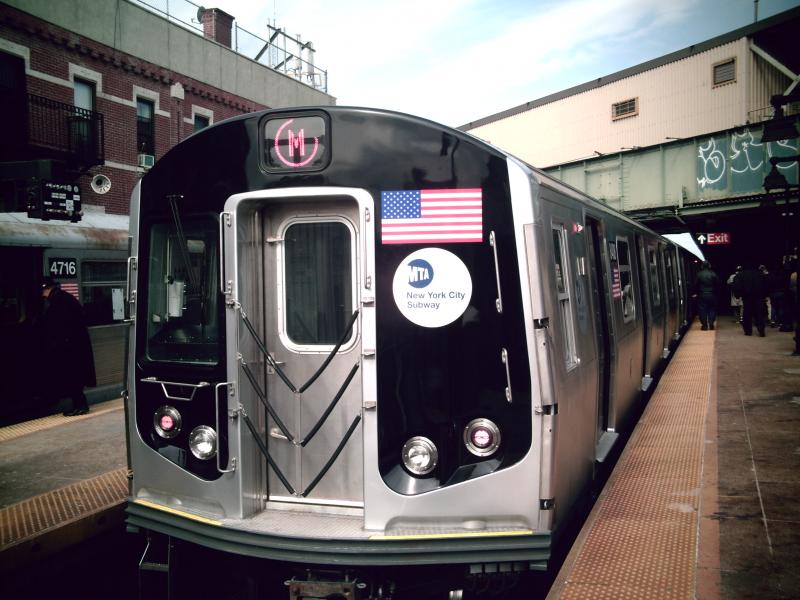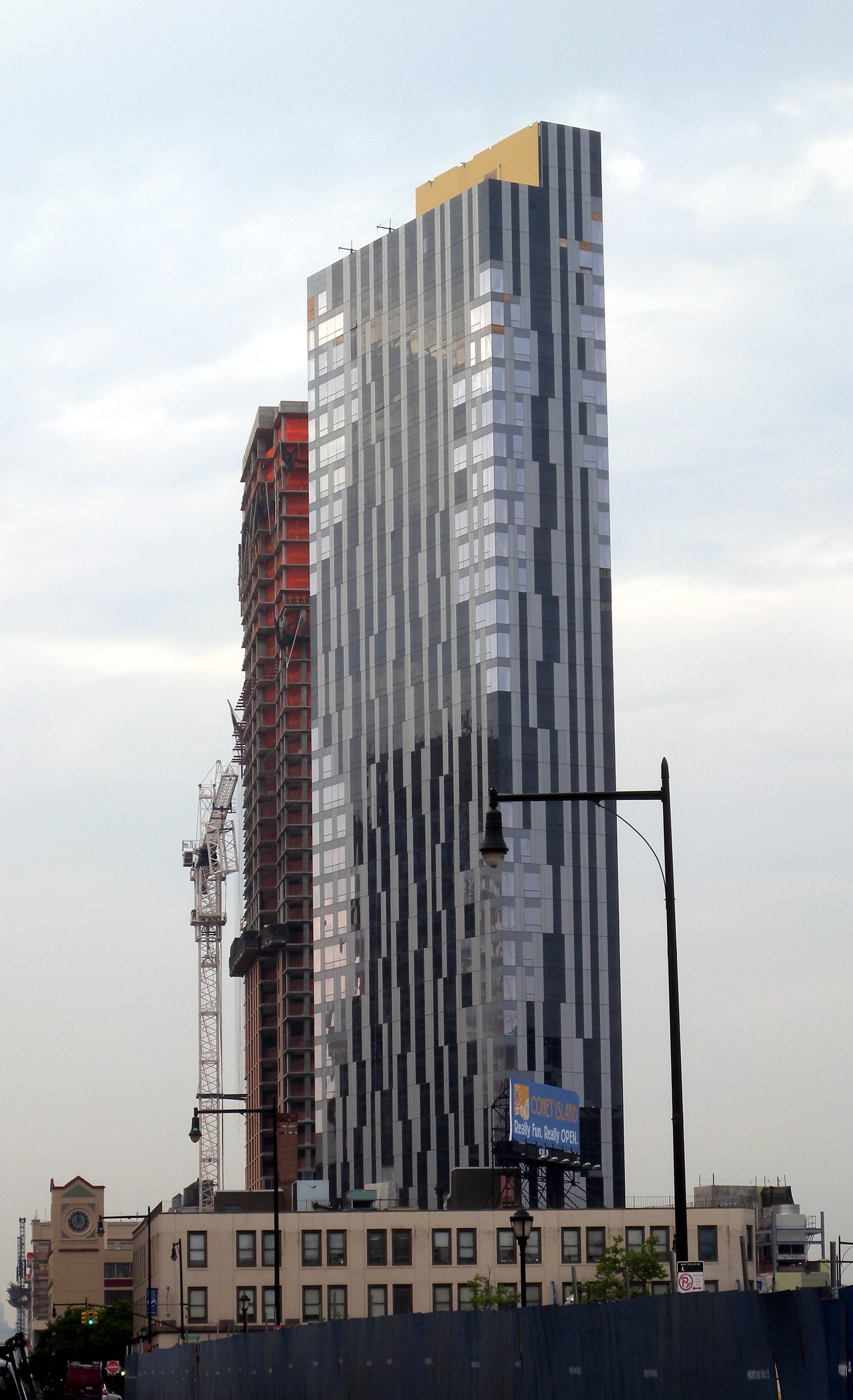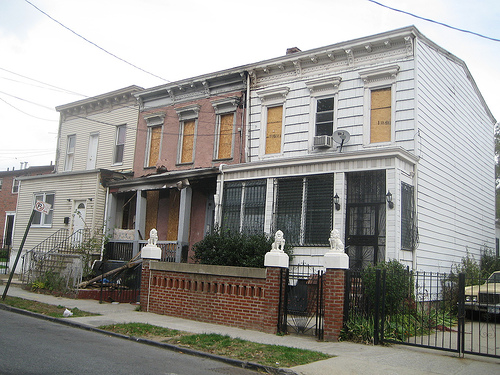|
Sumner Avenue (BMT Myrtle Avenue Line)
The Sumner Avenue station was a station on the demolished section of the BMT Myrtle Avenue Line. The station was located at the intersection of Myrtle Avenue and Sumner Avenues (now Marcus Garvey Boulevard) in Bedford-Stuyvesant, Brooklyn. The station opened in 1889, and closed in 1969. History The Myrtle Avenue Elevated was constructed by the Union Elevated Railroad Company, which was leased to the Brooklyn Elevated Railroad for its operation. The initial section of the line opened on April 10, 1888, running over Myrtle Avenue from Johnson and Adams Streets to a junction with what was then known as the Main Line at Grand Avenue. Trains continued along Grand Avenue and Lexington Avenue to Broadway, where the line joined the BMT Jamaica Line, Broadway Elevated, and then along Broadway to East New York. On April 27, 1889, the line was extended east along Myrtle Avenue to Broadway, including a station at Sumner Avenue. On October 4, 1969, the section of the Myrtle Avenue Elevated ... [...More Info...] [...Related Items...] OR: [Wikipedia] [Google] [Baidu] |
BMT Myrtle Avenue Line
The Myrtle Avenue Line, also called the Myrtle Avenue Elevated, is a fully elevated line of the New York City Subway as part of the BMT division. The line is the last surviving remnant of one of the original Brooklyn elevated railroads. The remnant line operates as a spur branch from the Jamaica Line to Bushwick, Ridgewood, and Middle Village, terminating at its original eastern terminal across the street from Lutheran Cemetery. Until 1969, the line continued west into Downtown Brooklyn and, until 1944, over the Brooklyn Bridge to the Park Row Terminal in Manhattan. Extent and service The following services use part or all of the BMT Myrtle Avenue Line: The Myrtle Avenue Line is served by the service. The line begins at Metropolitan Avenue in Middle Village, Queens. It heads southwest along a private right-of-way, eventually joining an elevated structure above Palmetto Street in Ridgewood and Myrtle Avenue in the Brooklyn neighborhood of Bushwick. Just before reaching B ... [...More Info...] [...Related Items...] OR: [Wikipedia] [Google] [Baidu] |
Island Platform
An island platform (also center platform, centre platform) is a station layout arrangement where a single platform is positioned between two tracks within a railway station, tram stop or transitway interchange. Island platforms are popular on twin-track routes due to pragmatic and cost reasons. They are also useful within larger stations where local and express services for the same direction of travel can be provided from opposite sides of the same platform thereby simplifying transfers between the two tracks. An alternative arrangement is to position side platforms on either side of the tracks. The historical use of island platforms depends greatly upon the location. In the United Kingdom the use of island platforms is relatively common when the railway line is in a cutting or raised on an embankment, as this makes it easier to provide access to the platform without walking across the tracks. Advantages and tradeoffs Island platforms are necessary for any station with m ... [...More Info...] [...Related Items...] OR: [Wikipedia] [Google] [Baidu] |
Brooklyn
Brooklyn () is a borough of New York City, coextensive with Kings County, in the U.S. state of New York (state), New York. Kings County is the most populous Administrative divisions of New York (state)#County, county in the State of New York, and the County statistics of the United States#Most densely populated, second-most densely populated county in the United States, behind New York County (Manhattan). Brooklyn is also New York City's most populous borough,2010 Gazetteer for New York State United States Census Bureau. Retrieved September 18, 2016. with 2,736,074 residents in 2020. Named after the Dutch village of Breukelen, Brooklyn is located on the western portion of Long Island and shares a border with the borough of Queens. It has several bridge an ... [...More Info...] [...Related Items...] OR: [Wikipedia] [Google] [Baidu] |
Broadway (BMT Myrtle Avenue Line)
The Myrtle Avenue station (announced on New Technology Trains as Myrtle Avenue–Broadway station) is a New York City Subway express station on the BMT Jamaica Line. Located at the intersection of Myrtle Avenue and Broadway in Bedford–Stuyvesant, Brooklyn, it is served by the J and M trains at all times, and by the Z during rush hours in peak direction. The station has two platform levels, but all regular passenger service is on the lower platform level of the station. The station has an abandoned upper platform level which previously served the BMT Myrtle Avenue Line to Downtown Brooklyn and Lower Manhattan via the Brooklyn Bridge. Just east of the station, the remaining section of the BMT Myrtle Avenue Line diverges from the BMT Jamaica Line via slip switches in an at-grade junction. History The lower level of the station opened on June 25, 1888. The upper level station, which was marked on signs as Broadway, opened on April 27, 1889, when the Myrtle Avenue Lin ... [...More Info...] [...Related Items...] OR: [Wikipedia] [Google] [Baidu] |
Tompkins Avenue (BMT Myrtle Avenue Line)
The Tompkins Avenue station was a station on the demolished section of the BMT Myrtle Avenue Line. The station was located at the intersection of Myrtle and Tompkins Avenues in Bedford-Stuyvesant, Brooklyn, one block east of the Myrtle–Willoughby Avenues station on the IND Crosstown Line, though there were no free transfers between the two stations. The station opened in 1889, and closed in 1969. History The Myrtle Avenue Elevated was constructed by the Union Elevated Railroad Company, which was leased to the Brooklyn Elevated Railroad for its operation. The initial section of the line opened on April 10, 1888, running over Myrtle Avenue from Johnson and Adams Streets to a junction with what was then known as the Main Line at Grand Avenue. Trains continued along Grand Avenue and Lexington Avenue to Broadway, where the line joined the Broadway Elevated, and then along Broadway to East New York. On April 27, 1889, the line was extended east along Myrtle Avenue to Broadway, inc ... [...More Info...] [...Related Items...] OR: [Wikipedia] [Google] [Baidu] |
Myrtle Avenue
Myrtle Avenue is a street that runs from Duffield Street in Downtown Brooklyn to Jamaica Avenue in Richmond Hill, Queens, in New York City, United States. Route description Queens Myrtle Avenue has been a major thoroughfare since the early 19th century, named after the myrtle trees that were plentiful in the area. Most likely, Myrtle Avenue began in Queens and was a plank road that charged a toll. The road eventually hosted the Knickerbocker Stage Coach Line, that ran stagecoach and omnibus services. After World War I, Myrtle Avenue in Glendale was a popular destination for picnickers. With a steam trolley running on the avenue, and its ample adjacent beer gardens and park space, people from as far as Eastern Brooklyn came to Myrtle. In the mid-1920s, the parks closed as a result of Prohibition. Ultimately, the parks became incorporated by the city into what is known today as Forest Park. Currently, Myrtle Avenue is one of the primary shopping strips of Ridgewood, alon ... [...More Info...] [...Related Items...] OR: [Wikipedia] [Google] [Baidu] |
Brooklyn Elevated Railroad
The Brooklyn Elevated Railroad was an elevated railroad company in Brooklyn, New York City, United States, operated from 1885 until 1899, when it was merged into the Brooklyn Rapid Transit Company-controlled Brooklyn Union Elevated Railroad. Lines * Lexington Avenue Line, downtown to Cypress Hills * Myrtle Avenue Line, downtown to Ridgewood, Queens * Broadway Line, Williamsburg to Cypress Hills **via incline and Long Island Rail Road Atlantic Avenue Division to Jamaica, Queens; also via New York and Rockaway Beach Railway to Rockaway Park, Queens * Fifth Avenue Line, downtown to Bay Ridge **via incline and Prospect Park and Coney Island Railroad to Coney Island; also via Long Island Rail Road Bay Ridge Branch The Bay Ridge Branch is a rail line owned by the Long Island Rail Road (LIRR) and operated by the New York and Atlantic Railway in New York City. It is the longest freight-only line of the LIRR, connecting the Montauk Branch and CSX Transpor ... and Manhattan Beac ... [...More Info...] [...Related Items...] OR: [Wikipedia] [Google] [Baidu] |
BMT Jamaica Line
The BMT Jamaica Line, also known as the Broadway - Brooklyn Line is an elevated rapid transit line of the B Division of the New York City Subway, in Brooklyn and Queens, New York City, United States. It runs from the Williamsburg Bridge southeast over Broadway to East New York, Brooklyn, and then east over Fulton Street and Jamaica Avenue to Jamaica, Queens. In western Jamaica, the line goes into a tunnel, becoming the lower level of the Archer Avenue lines in central Jamaica. The and trains serve the entire length of the Jamaica Line, and the serves the line west of Myrtle Avenue. The longest elevated line in the system, the Jamaica Line includes the oldest existing elevated structure in the system – the original 1885 line of the Brooklyn Elevated Railroad, the former BMT Lexington Avenue Line between Gates Avenue and Van Siclen Avenue – as well as the newest elevated structure, the 1988 ramp into the Archer Avenue subway. The Brooklyn–Manhattan Transit Corpora ... [...More Info...] [...Related Items...] OR: [Wikipedia] [Google] [Baidu] |
East New York
East New York is a residential neighborhood in the eastern section of the borough of Brooklyn in New York City, United States. Its boundaries, starting from the north and moving clockwise, are roughly the Cemetery Belt and the Queens borough line to the north; the Queens borough line to the east; Jamaica Bay to the south, and the Bay Ridge Branch railroad tracks and Van Sinderen Avenue to the west. Linden Boulevard, Pennsylvania Avenue, and Atlantic Avenue are the primary thoroughfares through East New York. East New York was founded as the Town of New Lots in the 1650s. It was annexed as the 26th Ward of the rapidly growing city of Brooklyn in 1886, and became part of New York City in 1898. During the latter part of the twentieth century, East New York came to be predominantly inhabited by African Americans and Latinos. East New York is part of Brooklyn Community District 5, and its primary ZIP Codes are 11207, 11208, and 11239. It is patrolled by the 75th Precinct of the ... [...More Info...] [...Related Items...] OR: [Wikipedia] [Google] [Baidu] |
Brooklyn Daily Eagle
:''This article covers both the historical newspaper (1841–1955, 1960–1963), as well as an unrelated new Brooklyn Daily Eagle starting 1996 published currently'' The ''Brooklyn Eagle'' (originally joint name ''The Brooklyn Eagle'' and ''Kings County Democrat'', later ''The Brooklyn Daily Eagle'' before shortening title further to ''Brooklyn Eagle'') was an afternoon daily newspaper published in the city and later borough of Brooklyn, in New York City, for 114 years from 1841 to 1955. At one point, it was the afternoon paper with the largest daily circulation in the United States. Walt Whitman, the 19th-century poet, was its editor for two years. Other notable editors of the ''Eagle'' included Democratic Party political figure Thomas Kinsella, seminal folklorist Charles Montgomery Skinner, St. Clair McKelway (editor-in-chief from 1894 to 1915 and a great-uncle of the ''New Yorker'' journalist), Arthur M. Howe (a prominent Canadian American who served as editor-in-chief from ... [...More Info...] [...Related Items...] OR: [Wikipedia] [Google] [Baidu] |
Defunct BMT Myrtle Avenue Line Stations
{{Disambiguation ...
Defunct (no longer in use or active) may refer to: * ''Defunct'' (video game), 2014 * Zombie process or defunct process, in Unix-like operating systems See also * * :Former entities * End-of-life product * Obsolescence Obsolescence is the state of being which occurs when an object, service, or practice is no longer maintained or required even though it may still be in good working order. It usually happens when something that is more efficient or less risky r ... [...More Info...] [...Related Items...] OR: [Wikipedia] [Google] [Baidu] |






